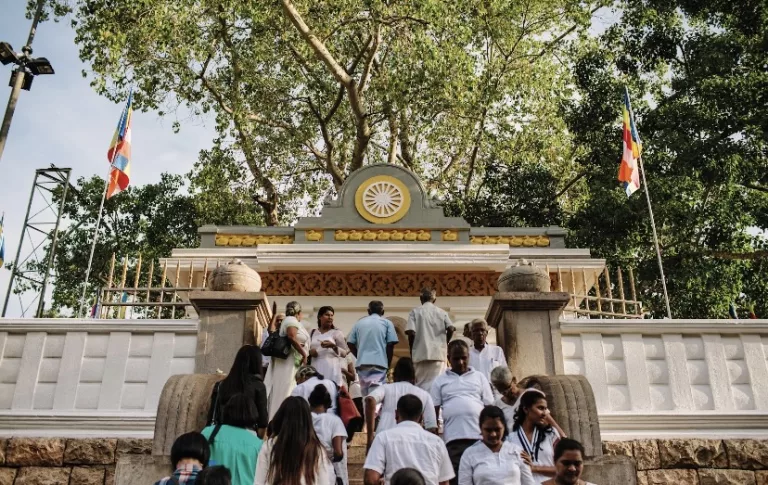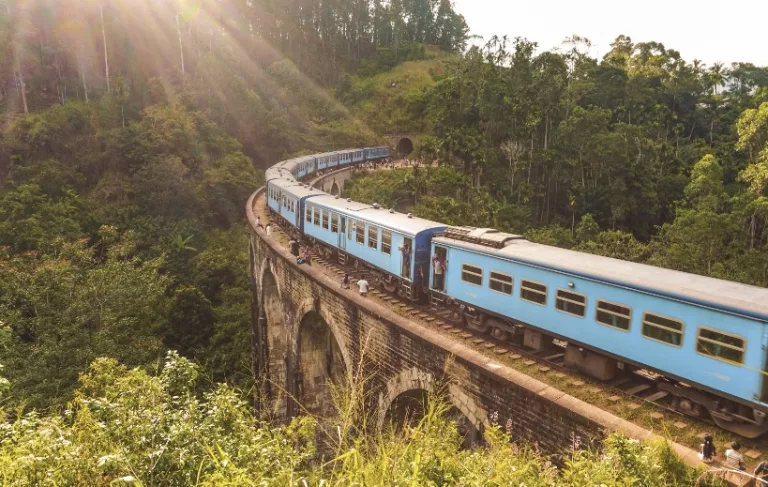It’s pouring with rain and the four of us, sharing two umbrellas, are standing between two gigantic lion’s paws.
Like a scene straight out of Lord of The Rings, the pair of monumental paws form what was once the base of a whole lion, created from as many as three million stones and bricks, and stretching to the top of the sheer sided, massive monolith of red rock, that looms 200m above us.
Sigiriya, Lion Rock, the Castle in the Sky, call it what you will, this ancient fortress, perched on the top of rock that juts dramatically over the forests of central Sri Lanka, must once have been truly awe-inspiring. But then this was surely the point; a warning to potential intruders.
The origins of Sigiriya’s habitation are shrouded in myth and mystery, unsurprising when you realise they stretch back 5,000 years. What remains here today is a more recent legacy, dating back a mere 2,500 years, to the reign of King Kashyapa, and like all great ruins, this one comes with a dramatic story.
Kashyapa is said to have entombed his father alive, in the process stealing the throne from his half-brother, who then fled to India, to plot his terrifying and brutal revenge. Fearing this scenario, Kashyapa sought refuge atop the mighty rock and set about building a fortress as ornate as it was heavily fortified.
Standing at the foot of this once mighty fortress, there are 1,270 steps ahead of us, which sounds like rather a lot, and the rain is getting heavier. We climb through the paws and onto a slightly less impressive metal staircase, that clings to the rock face by way of some rusty looking attachments.
Hundreds of steps later we reach a final dizzying flight of stone stairs, each cut from quartz, so that, in the aeons before electricity, they’d shine brightly in the moonlight. This final section takes its toll, but it’s the view from the top that takes the last of our breath away.
Spread out before us, 360° sweeping views of the surrounding mountains and below, the remains of moats, ramparts, palaces, an ancient monastery and elaborate water gardens. We can hardly take it all in. One last look at the rain-soaked view and it’s time to trot back down all those steps.
We aren’t done with stairs for the day. We’ve one more visit to make, Dambulla, a UNESCO World Heritage site and one of the most beautifully preserved cave temples in Asia. A hasty wardrobe change in the back of the bus and we replace the morning’s wet clothes with something dry, that covers our shoulders and knees, as required for temple visits. Grabbing the umbrellas, we set off up the 370 granite stairs, that stand between us and the temple complex.
Picture: Sourced
The rewards are spectacular. Dambulla cave temples, hewn into a granite outcrop, towers 160m over the surrounding plains. Thought to be over 2,000 years old, they are still home to Sri Lankan Buddhist monks. The five cave temples, spread out under a vast overhanging rock, are filled with a collection of ancient murals, intricately painted ceilings and 153 hand-carved stone statues of the Buddha. After a couple of hours of stone sculpture splendour and wonderous wall art though, we’re a bit templed out and decide to call it a day.
We’re on a roll with temples, monuments and history. The previous day we’d visited Anuradhapura, the first ancient capital of Sri Lanka and a city that had thrived from the 4th century BC to the 11th century AD. Giant stupas tower above the tropical jungle, mystical moonstones mark the entranceways to temples, and ruins of vast monastic complexes lay scattered over several square kilometres.
For nearly a millennium, Anuradhapura’s kings commissioned opulent palaces, intricate sculptures, vast stupas, some of the world’s first hospitals, and monasteries and monastic colleges that were some of the oldest universities in the world.

Picture: Sourced
All this centred around one of the world’s oldest trees, the sacred Sri Maha Bodhi Tree, a 3rd century BC cutting from the famous Bodhi tree in India, where the Buddha had sat and gained enlightenment. We cycled the sprawling sites of Anuradhapura with a local guide. Along the streets and byways, through more than a dozen archaeological sites, past gargantuan stupas and ingenious ancient irrigation works; a pretty mind blowing experience.
ALSO READ: Discovering Sierra Leone: A captivating gem
Our last scheduled temple destination was Kandy. Once the capital of an ancient kingdom, Kandy is tucked beside a lake, in the middle of Sri Lanka’s central highlands and surrounded by tea plantations. Kandy is home to The Temple of the Tooth Relic, a teeming complex which houses the relic of the tooth of Buddha, resting in a golden casket, encased with golden bands, encrusted with golden medallions and dripping with ropes of shimmering pearls. According to legend, mourners had rescued the tooth from the Buddha’s cremation pyre, nearly 2,500 years ago. Since ancient times this tooth has played an important role in Sri Lanka’s politics. Wars have been fought over it – myth has it that whoever possesses the tooth is destined to rule Sri Lanka.
The tooth attracts more than a million pilgrims every year. Once inside the temple, we were squeezed into a narrow corridor. Drums beat, devotional candles flickered, the air was heavy with the fragrance of floral offerings and barefooted devotees waited patiently for the temple’s interior doors to open and reveal the sacred relic.
Done with temples, done with crowds, done with congestion and done with chaos, we needed some ‘alone time’ in the tea country.

Picture: Sourced / Adam Vandermeer
Before we’d left home my Instagram feed had been full of travellers leaning out of a bright blue train and looking out at vibrant green tea plantations, and now here we were, on the very same train. Curtains of eucalyptus and pine trees to one side, mountains and towering ravines on the other. Travellers and locals alike swung out the open doors, catching the breeze and posing for photos, while vendors offered samoosas and other snacks. Climbing down at Hatton station, we were whisked off into the world of tea.
Most of us only associate tea with that little mesh bag we pull from a box and unceremoniously dunk in hot water. Ask about the plant it comes from and you’ll likely be met with a blank look. But come to the tea country, away from the world of mass-produced tea bags and you’ll soon discover another side to tea, and another side to Sri Lanka.
We were staying at Ceylon Tea Trails, a collection of five restored tea planters’ bungalows dotted among the plantations of the Dilmah tea estates. With a nostalgic charm and a distinctly British feel, the estate harks back to Sri Lanka’s colonial past, with butlers, sumptuous afternoon teas, manicured gardens and croquet on the lawn. We felt entirely removed from the world outside of the valley and this was just what we needed after the town and temple overload of the previous week.
Leisurely meals, luxurious picnics, walks, massages, dips in the pool and wicker chairs overlooking the lake. The view was spectacular. Surrounded by tea fields, hundreds and thousands of bottle-green bushes, dotted with tea pickers, each busily plucking the top few emerald leaves to fill the sacks on their backs. A tour of the weather-beaten tea factory a couple of days later, gave us some insights into the process of tea production, from the picking to the packing, and certainly made me think twice about ever adding milk and sugar again!
The final leg of our Sri Lankan odyssey was to the coast. One of the best things about Sri Lanka is that because it’s so compact, you’re never far from anything, and our next stop was Galle, a beautiful city with a vibrant history to match. Situated on the coast, the bright white Galle Fort, which dates back to 1663, is a place of cobblestoned streets and Dutch colonial buildings. Galle’s origins are ancient. As a seaport it dates back millennia; cinnamon has been shipped from here for a thousand years, and it was here that King Solomon came for ivory, peacocks and other treasures. After Portuguese and then Dutch colonisation, Galle became a hotspot on the spice route and Sri Lanka’s main port for the next 200 years.
Early in the mornings, to beat the heat and the crowds, we wandered the still quiet streets of the old town. Visiting the magnificent gabled Dutch Reformed Church and the ochre-coloured Old Dutch Warehouses. Passing through Law Court Square, shaded by ages-old banyan trees, and beyond it to the Galle Dutch Hospital. We climbed the ramparts at Aurora Bastion and wandered past the slender lighthouse, ending up at Moon Bastion, which overlooks the new town and the cricket ground. Later in the day we visited shops and quirky cafés, and in the evenings, drank gin and tonics or arrak, made from the fermented sap of coconut flowers, on our hotel’s verandah and people watched.
An hour’s drive from Galle, we passed through paddy fields, coconut plantations and cinnamon estates, before reaching Balapitya, a peaceful oasis, a tranquil, traditional coastal fishing village, with golden soft beaches and the endless Indian Ocean stretching out to the horizon. We spent our last two days here, soaking up the beach, and doing absolutely nothing at all! We walked, we swam, we ate, we slept.
For centuries Sri Lanka has been popular with foreign travellers. Around 300BC, at the time of Alexander the Great, the ancient Greeks called the island Palaesimoundu, meaning ‘beyond the sea’, and wrote of its mythical treasures. Chinese Buddhist monk, Fa-Hien, visited Sri Lanka in about 410AD and liked it so much he stayed for two years. In the twelfth century, Italian explorer Marco Polo declared Sri Lanka the “best island of its size in the world”.
In 1896 Mark Twain wrote “Dear me, it is beautiful… Oriental charm and mystery, and tropic deliciousness.” This is a world in one island. Palm fringed beaches, rice paddies and lily ponds, ancient cities, lush rainforests, fabulous tea estates and generous, warm, welcoming people; this tear-drop shaped island definitely doesn’t disappoint.
ON A NEED TO KNOW BASIS
Sarah’s Sri Lanka itinerary was planned by Jacada Travel https://www.jacadatravel.com/
Visiting Anuradhapura, Sigiriya and Dambula, stay at Uga Ulagalla. https://www.ugaescapes.com/ulagalla/
Visiting Kandy, stay at King’s Pavilion. https://www.kingspavilion.com/
Visiting the tea country, stay at Ceylon Tea Trails https://www.resplendentceylon.com/teatrails/
Visiting Galle, stay at Fort Bazaar. https://www.teardrop-hotels.com/fort-bazaar/
Visiting Balapitya, stay at Kumu Beach https://www.teardrop-hotels.com/kumu-beach/
This article was written by Sarah Kingdom for Getaway’s April 2024 print edition. Find us on shelves for more!
Follow us on social media for more travel news, inspiration, and guides. You can also tag us to be featured.
TikTok | Instagram | Facebook | Twitter
ALSO READ: Viva Vilankulo – Tropical beauty worth exploring!

